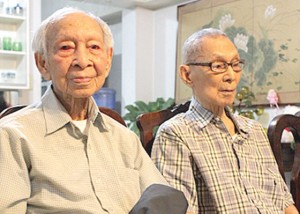Two brothers—107 and 105 years old, respectively—are the oldest living World War II Filipino veterans who saw action in Bataan 73 years ago and survived to tell their tales.
President Benigno Aquino 3rd will lead the nation in the 73rd “Araw ng Kagitingan” (Day of Valor) observance on Thursday to honor World War II veterans, both Filipinos and Americans, who fought during the Second World War.
Now in the twilight of their lives, Capt. Fernando P. Javier, 107, and his younger brother, Capt. Jose P. Javier, 105, a retired doctor, thanked God for His infinite mercy for sparing their lives during the war, especially during the bloody battle in Bataan against the invading Japanese forces from January 7 to April 9, 1942.
The ferocious fighting left 10,000 killed on the side of the American and Filipino forces while the Japanese suffered 7,000 dead during the three months and two days of mortal combat, according to military historical records.
In addition, Allied forces suffered 20,000 wounded while the Japanese sustained 12,000.
A total of 75,000 Filipino and American soldiers were held prisoners of war and forced to participate in the infamous Bataan Death March that left thousands dead because of exhaustion and lack of food and medicines.
Filomena Javier, 89, said her husband Jose is still active, walking around the house as a light exercise but does not forget to pray the Holy Rosary thrice a day.
“My husband is always reminding me about the importance of praying the Rosary because he believes it was prayer that saved his life and that of his brother during the war,” Mrs. Javier added.
“His memory is still sharp and he talks with a loud voice during our conversation, apparently to emphasize what he says,” she said.
“However, he only talks if he wants to, otherwise he just sits on the chair and closes his eyes most of the time but does not forget to take his breakfast, lunch, snack and dinner,” according to Mrs. Javier.
“When my husband celebrated his 105th birthday last February 19, I did not prepare a birthday bash but when a friend of ours, Cherry Lopez Cavistani, came for a visit, he told me to prepare something,” she said.
“Mrs. Cavistani said she is thankful to my husband for saving her life when she was gravely ill while my husband was still a practicing doctor,” Mrs. Javier added.
She said that during her husband’s birthday, he insisted to hear Mass at Christ the King Seminary in Quezon City, the first time in many months since because of old age, he could not attend Mass every Sunday.
“People who knew him were happy to see my husband going to Mass and greeted him happy birthday,” she said. “My husband was stricken ill with pneumonia recently. We brought him to St. Luke’s Medical Center and he recovered.”
Javier, a member of the Philippine Scouts, is one of the few living WWII veterans who have breached the century mark. His elder brother, Fernando, 107, resides in Baguio City.
Though older by two years, Fernando still walks around. He is physically healthier and stronger than Jose.
In his memoirs “A Century’s Journey,” Capt. Jose Javier said that as a member of the medical corps, he was not armed and to crawl to reach and treat wounded Filipino and American soldiers in the middle of the fighting was doubly more dangerous and risky.
He wrote: “Our troops dug in and fought from their foxholes. Our cannons fired continuously day and night. But the Japanese could not be stopped. Their advance could only be delayed. There were periods when all was quiet at the front… Then they would attack again. Only Japanese planes were flying in the sky. Fortunately, they did not do much damage to the troops who were not their main targets, except for occasional strafing.
Their main targets were our artillery which were wreaking havoc on their troops.
“However, their frequent sorties with no friendly planes to challenge them were very demoralizing to us. News from the US received by clandestine radio reported that reinforcements promised by President Roosevelt were on their way. That buoyed us up.
But one month passed. Two months, three months, and still, no reinforcements. Several times, overpowered by the enemy, we retreated to a pre-determined line of defense which our troops could hold at all cost. ‘No more retreat’ was the order. But our troops could only hold for a period of time. Finally, we were pushed to the foot of Mt. Samat.”
He said the Death March was “day and night without any stop, without food or water.” But civilians along the way gave them water in cans, Capt. Javier said.
“We helped ourselves when not seen by the guards who did not want us to get out of the column. I chanced upon Dr. Fernando Tinio of the Clearing Company. He had thrown away his shoes because his feet were all blisters, and he wrapped his feet with towels. I walked slowly with him for a while at the rear of the column. Fortunately, the guard was not cruel. He just prodded us to walk faster to catch up with the rest.”
Javier said that after five days and nights of walking, he reached San Fernando, Pampanga but it took longer for others.
He said the Japanese dug a hog pit where the POWs relieved themselves. “It was nauseating,” he added.
In his memoirs on the Death March, Javier said: “It is estimated that at least 600 Americans and between 5,000 and 10,000 Filipinos lost their lives during the march.” PNA


